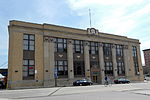Green Mount Cemetery is a historic rural cemetery in Baltimore, Maryland, United States. Established on March 15, 1838, and dedicated on July 13, 1839, it is noted for the large number of historical figures interred in its grounds as well as many prominent Baltimore-area families. It retained the name Green Mount when the land was purchased from the heirs of Baltimore merchant Robert Oliver. Green Mount is a treasury of precious works of art, including striking works by major sculptors including William H. Rinehart and Hans Schuler.
The cemetery was listed in the National Register of Historic Places in 1980. Guided tours are available at various times of the year.
A Baltimore City Landmark plaque at the entrance reads:
Green Mount Cemetery was dedicated in 1839 on the site of the former country estate of Robert Oliver. This was at the beginning of the "rural cemetery movement"; Green Mount was Baltimore's first such rural cemetery and one of the first in the U.S. The movement began both as a response to the health hazard posed by overcrowded church graveyards, and as part of the larger Romantic movement of the mid-1800s, which glorified nature and appealed to emotions.
Green Mount reflects the romanticism of its age, not only by its very existence, but also by its buildings and sculpture. The gateway, designed by Robert Cary Long, Jr., and the hilltop chapel, designed by J. Rudolph Niernsee and J. Crawford Neilson, are Gothic Revival, a romantic style recalling medieval buildings remote in time.
Nearly 65,000 people are buried here, including the poet Sydney Lanier, philanthropists Johns Hopkins and Enoch Pratt, Napoleon Bonaparte's sister-in-law Betsy Patterson, John Wilkes Booth, and numerous military, political and business leaders.
In addition to John Wilkes Booth, two other conspirators in the assassination of Abraham Lincoln are buried here, Samuel Arnold and Michael O'Laughlen. It is common for visitors to the cemetery to leave pennies on the graves of the three men; the one-cent coin features the likeness of the president they successfully sought to murder.The abdicated King Edward VIII and his wife, the Duchess of Windsor, had planned for a burial in a purchased plot in Rose Circle at Green Mount Cemetery, near where the father of the Duchess was interred. However, in 1965 an agreement with Queen Elizabeth II allowed for the king and duchess to be buried near other members of the royal family in the Royal Burial Ground near Windsor Castle.








